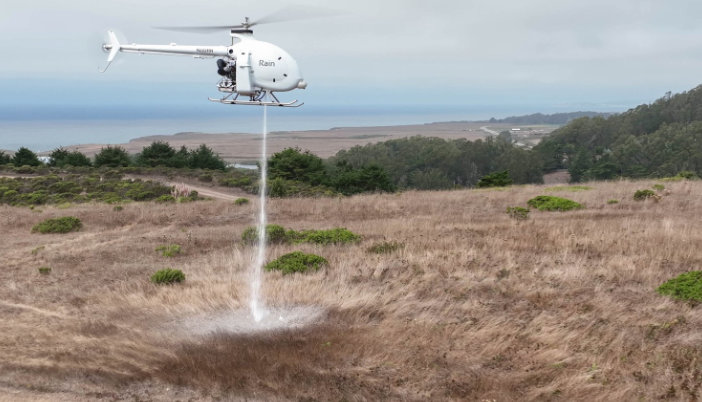Last month, Rain announced a $9.7M Seed Round led by DBL Partners, with participation from VoLo Earth Ventures, Kapor Capital, and Convective Capital. The funding will be used to advance pilot projects in the United States and enable rapid wildfire response with prepositioned autonomous aircraft.
In 2022, the UN Environment Programme (UNEP) reported that climate and land-use change are causing wildfires to become worse, expecting a 14% global increase in extreme wildfires by 2030. The US Department of Commerce’s National Institute of Standards and Technology (NIST), states that extreme wildfires can cause damages that result in a total annualized cost averaging $348 billion per year in the US alone. As an aerial wildfire containment technology developer, Rain’s mission is to fight climate change, help firefighters save lives, and protect property by developing autonomous firefighting aircraft.
“Catastrophic wildfires are a climate flywheel we cannot ignore,“ said Nancy Pfund, Founder and Managing Partner at DBL Partners and board member at Rain. “18% of total global fossil fuel CO2 emissions were emitted by wildfires in 2021. The CO2 emissions from the 2023 Canadian wildfires are approaching three times the annual emissions of the state of California. As an impact venture capital firm, we at DBL see Rain’s mission as the epitome of Double Bottom Line Investing.”
Recent policy guidance by the White House and Congress encourages or even requires fire agencies to develop plans to adopt autonomous aircraft for rapid wildfire suppression. Other than the autonomous firefighting aircraft, Rain has also developed the Wildfire Mission Autonomy System to rapidly perceive, understand, and suppress early-stage wildfire ignitions. To achieve this, the system integrates with camera feeds and other early detection sensors.
For example, in California alone, there are already more than a thousand fire watch cameras continuously monitoring over 90% of the state’s extreme and high fire-threat areas. Rain’s software takes advantage of those cameras to dispatch nearby autonomous helicopters within seconds, so that fires can be contained within minutes.
According to a recent report by The Moore Foundation, a 15-minute improvement to wildfire response time could generate an economic benefit of $3.5-8.2 billion dollars in California alone. In late 2022, the company ran its first fire containment test flight, where Rain’s onboard fire mapping system, which takes advantage of computer vision and autopilot systems, pinpointed a fire source to within 6 ft.
In early October 2023, Rain started a collaboration with Sikorsky to advance rapid response capabilities for aerial wildland firefighting. Together, both companies will explore how Sikorsky’s MATRIX autonomy suite operating with Rain’s Wildfire Mission Autonomy System can launch uncrewed helicopters to drop water on wildfires within minutes of detection. This collaborative effort will use Rain's system to upload mission commands to Sikorsky’s Optionally Piloted BLACK HAWK helicopter with no crew on board for the fastest response time.
“The steady rise of catastrophic wildfires is plain to see. Aerial firefighting is one of the most important use cases for autonomous flight, where Rain’s technological leaps can shorten response times, keep pilots out of harm’s way, and increase total fire suppression capabilities at a time when we sorely need them,” said John Collison, President of Stripe. “Bring on the firefighter drones!”
















Comments